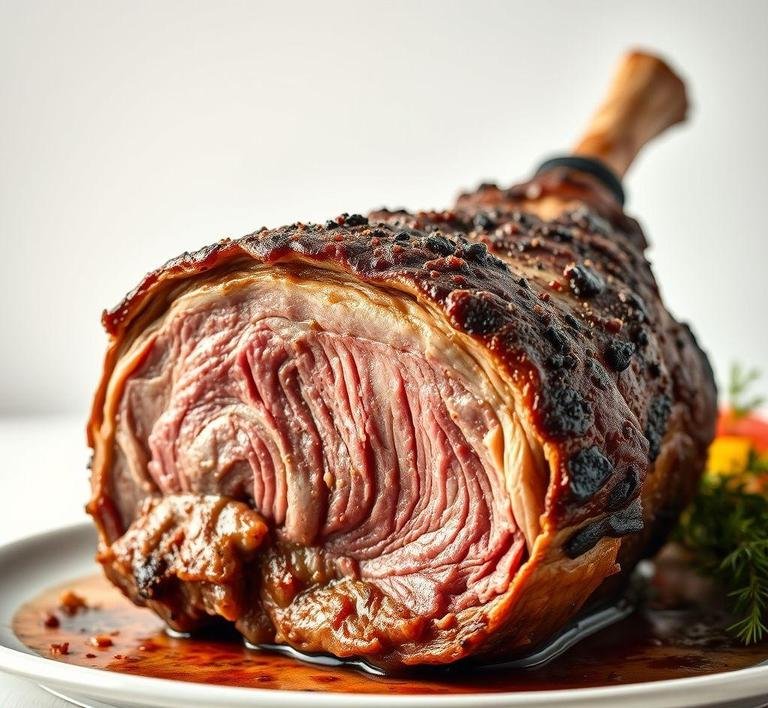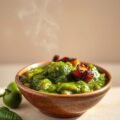Jamie Oliver’s Slow Cooked Lamb Leg is one of those dishes that feels like a warm hug on a plate. It’s a classic, rustic recipe where a whole leg of lamb is cooked low and slow, allowing the meat to turn incredibly tender and juicy. Instead of rushing, the slow cooking breaks down the connective tissues, making the lamb melt in your mouth.
What sets Jamie’s version apart is his knack for layering flavors. He doesn’t just cook the lamb plain; he infuses it with herbs, garlic and spices that soak deep into the meat over hours. The result is rich, aromatic and packed with that earthy lamb flavor but balanced with freshness from herbs and a subtle sweetness.
This dish is perfect for gatherings or a special family meal because it’s impressive yet surprisingly simple to prepare. You just need patience and Jamie’s recipe rewards you with melt-away meat and a sauce that’s practically begging for bread.
Jamie Oliver Slow Cooked Lamb Leg Recipe
Ingredients Needed
To nail Jamie Oliver’s Slow Cooked Lamb Leg, you don’t need a long list of fancy ingredients. It’s mostly about quality and freshness:
- Leg of lamb (bone-in, about 2 to 3 kg): The star of the show. Bone-in adds flavor and keeps the meat juicy.
- Garlic cloves: Jamie loves to shove garlic into the lamb – it’s essential.
- Fresh rosemary and thyme: These herbs are crucial. Rosemary pairs beautifully with lamb and thyme adds an earthy touch.
- Olive oil: To rub over the lamb, helping the herbs stick and giving a nice crust.
- Salt and freshly ground black pepper: Simple seasoning but essential.
- Red wine or stock: For the slow-cooking liquid that creates a rich sauce at the end.
- Onion, carrots and celery: Jamie uses these to create a flavorful base in the roasting tray which also helps with the sauce.
Optional extras might include a squeeze of lemon or some dried chili flakes for a bit of heat but Jamie keeps it straightforward, relying on fresh ingredients to shine.
Equipment Needed
You won’t need anything too fancy but a few essentials make this dish a breeze:
- Roasting tray: Big enough to hold the lamb and some veggies comfortably.
- Sharp knife: For making small incisions to insert garlic cloves into the lamb.
- Kitchen twine (optional): If you want to tie the leg to keep a neat shape.
- Aluminum foil: To tent the lamb and let it rest after cooking.
- Oven: Obviously – the heart of slow roasting.
- Meat thermometer (optional but recommended): To check the internal temperature and get the perfect doneness.
- Basting brush or spoon: To spoon juices over the lamb during cooking.
That’s pretty much it! No complicated gadgets needed, just basic tools and patience.
How To Make Jamie Oliver’s Slow Cooked Lamb Leg
Alright, here’s where the magic happens.
- Prep the lamb: Start by making small slits all over the lamb leg with your sharp knife. Push peeled garlic cloves and small sprigs of rosemary into these cuts. This step is where the flavor goes deep.
- Season well: Rub olive oil all over the lamb, then season generously with salt and pepper. Don’t be shy here. seasoning is key to bringing out the flavors.
- Veggie base: Scatter roughly chopped onion, carrot and celery in your roasting tray. This acts like a flavor bed for the lamb to sit on and creates a delicious base for your sauce.
- Add liquid: Pour a good splash of red wine or stock into the tray. This will keep the meat moist and create juices for the sauce.
- Slow roast: Pop the lamb into the oven at a low temperature. usually around 140°C (275°F). The key is slow and steady. This can take anywhere from 3 to 4 hours depending on size. The goal is tender, falling-apart meat.
- Baste occasionally: Every hour or so, spoon the juices from the tray over the lamb to keep it moist and flavorful.
- Rest: Once done, cover the lamb loosely with foil and let it rest for 20-30 minutes. This lets the juices redistribute, so when you carve, the meat stays juicy.
- Serve: Pull the lamb apart or carve in slices. Use the tray juices as a sauce. you can reduce it a bit on the stove for extra intensity.
What I Learnt

Making this dish was an eye-opener on the power of patience in cooking. At first, I wanted to crank the heat and rush it but slowing down was the real secret to juicy, tender lamb. The simple act of inserting garlic and herbs into the meat transformed the flavor so much. it wasn’t just roasted lamb, it was infused with fragrant garlic and rosemary in every bite.
Also, I realized how the veggie base is more than just decoration. It absorbs all the meat juices and creates a rich sauce that’s the perfect finishing touch. Basting was a small extra step but it made the lamb glisten and stay moist.
Lastly, resting the meat was crucial. Cutting straight from the oven meant juices ran out but resting kept everything tender and succulent.
Recipe Tweaks For Jamie Oliver’s Slow Cooked Lamb Leg
Jamie’s slow-cooked lamb leg is already a masterpiece but tweaking it can take things to a whole new level. First off, think about the seasoning. Jamie usually goes simple-rosemary, garlic, olive oil. but adding a bit of smoked paprika or ground cumin can introduce a subtle smoky warmth. It’s like giving the lamb a cozy, aromatic hug.
Next, the liquid you cook it in can make a big difference. Jamie often suggests red wine or stock but why not experiment? A splash of pomegranate juice or even a bit of balsamic vinegar can add a beautiful tangy sweetness that cuts through the richness of the meat. And don’t underestimate the power of slow cooking with onions and carrots layered under the lamb; they turn into a natural gravy once the meat’s done.
Oh and one pro tip-marinate the lamb overnight. Jamie usually rubs the herbs on right before cooking but giving those flavors a night to sink in helps the meat soak up all those vibrant tastes. A bit of honey or maple syrup in the marinade can add a hint of caramelized sweetness when the lamb crisps up in the oven at the end.
Storage Tips For Leftovers
Leftover slow-cooked lamb? Jackpot. But storing it right is key. First, let the lamb cool down to room temperature. but no longer than two hours. Slice it into portions or shred it if you like, because smaller pieces chill faster and are easier to reheat evenly.
Store the lamb in airtight containers. If you’ve got some of that rich cooking liquid or gravy, pour a little over the meat before sealing. It keeps the lamb moist and prevents it from drying out in the fridge. You can keep it refrigerated for up to 3-4 days.
For longer storage, freezing is your friend. Wrap the lamb tightly in cling film or foil before popping it into a freezer bag. Label it with the date so you don’t lose track. Frozen lamb stays good for about 3 months. When reheating, do it gently-low heat in the oven or simmer it on the stove with a splash of stock or water to keep it juicy.
What To Eat With Jamie Oliver’s Slow Cooked Lamb Leg?
Pairing sides with slow-cooked lamb is an art. Jamie often keeps it rustic and that’s perfect here. Think creamy mashed potatoes-soft, buttery and perfect for soaking up the lamb juices. Or roast some root veggies like carrots, parsnips and potatoes tossed with rosemary and garlic; their natural sweetness complements the savory lamb beautifully.
A fresh contrast also works wonders. A crisp green salad with lemon vinaigrette or a simple rocket and pomegranate seed salad can cut through the richness and brighten the plate.
For something a bit more adventurous, try a mint yogurt sauce or a chimichurri. The mint adds a classic fresh kick while chimichurri brings vibrant herbaceous notes that complement the lamb’s slow-cooked depth.
Don’t forget some good bread-crusty and chewy to mop up every last bit of sauce.
FAQs
How Long Should I Cook Jamie Oliver’s Slow-cooked Lamb Leg?
Jamie suggests cooking it for around 4 to 5 hours on a low heat, until it’s tender and falling apart.
Can I Cook Jamie Oliver’s Slow-cooked Lamb Leg In A Slow Cooker?
Yes! Just set it on low for 6 to 8 hours, and you’ll get the same delicious result.
What Seasoning Does Jamie Use For The Slow-cooked Lamb Leg?
He uses a mix of garlic, rosemary, thyme, and olive oil, giving the lamb a rich, herby flavor.


